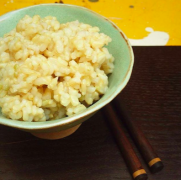Brown rice: the preparation secret you need to know
When I tried brown rice for the first time, I went “Nope, I ain’t gonna have a bar of this”. I grew up on sweet, sticky medium grain white rice. The texture of dry and husky brown rice, that didn’t seem to break up in my mouth, was an offense to my upbringing and my love for rice altogether.
Then one day, my friend served me brown rice that was so succulent and easy to bite, that I fell in love. And when I was told what the secret to making succulent brown rice was, I knew that process was the right way to unlock the hidden juiciness of this wholesome grain.
By now, most of us know that brown rice and whole grains are better for you than their refined cousins. What you may not know, is that the way we prepare these grains is so important, that not getting it right might cancel out the benefits we are seeking in the first place. So what can you do to improve digestion, or even help to heal your gut?
When we eat grains without properly preparing them, something blocks nutrients from reaching our digestive system. It is called phytic acid.
Phytic acid is present in all grains and legumes. Its main purpose is to protect seeds from an untimely death in the digestive tract of an animal (like us!). It also helps many seeds by giving them the energy to sprout. Of course, the whole point of a seed’s life is to germinate and sprout, then to mature into a plant and make its own seedlings. The cycle goes on. The thing is, seeds are delicious and nutritious for many animals! We want rice ‘cause rice is nice! So how do we get around this amazing natural shield to the juicy stuff? Phytic acid binds to all minerals and vitamin B groups, making them “unavailable” for us to absorb and use. This is why phytic acid is often referred to as an anti-nutrient.
Sounds bleak, doesn’t it? But there IS a way around this!
Soaking grains and seeds create an environment in which they can start breaking down their own shield to prepare themselves for spouting. This is why it’s a great idea to soak all our grains and legumes before cooking. Although cooking can reduce phytic acid to a degree, soaking is a real game changer! Let me put it this way: if you’re going to switch from white rice to brown rice four the health benefits (there are so many – I’ve summarised them for you at the end of this blog), you might as well make sure you are able to absorb those benefits in your gut, right?
So here’s what you need to do for optimal nutrient absorption:
- Soak brown rice in lukewarm water (tap water temperature would do). Studies show the best temperature for germination of brown rice is 25 degrees C (86 – 104 degrees F) for 20 hours. Try soaking your rice overnight and leave it while at work, and leave it in a sunny spot like a windowsill.

2. If you can, change the water a couple of times. As the grains start breathing, they start farting too! So changing the water is important. If you’re out all day, even changing the water once, like when you get home, will prevent the rice from smelling ‘unpleasant’ instead of ‘like rice fart’?! like rice fart. See the image below? That’s the rice fart bubbling up!
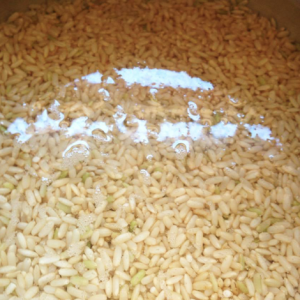
3. Rinse and drain the rice before cooking.
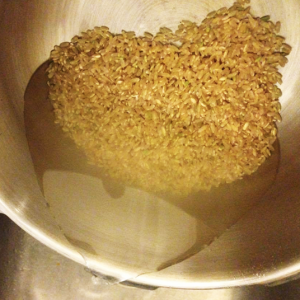
4. The convention has it that you ‘use’ 1 cup of rice ‘to every 1.5 cups of water for cooking’. But since you have soaked the rice for 20 hours and have rinsed out the initial water you used, ‘the quantity of water needed to cook it, is now less than normal.’ Here is the trick of the trade: place your hand gently on the rice and if the water just touches the lower part of your fingers, then you are safe. Check out the picture. Naturally, if your hands are massive, then use a little less. You will quickly find out if you should use more or less water with this measuring method.
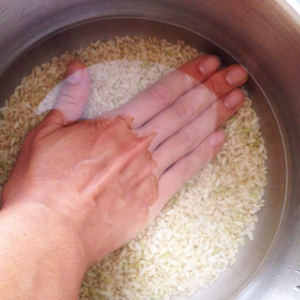
5. I personally prefer using a pressure cooker, as it saves energy and lessens the cooking time. But you can use an ordinary pot.
- If you are using a regular pot, start boiling with a lid on
- Once the contents are boiling, keep it at that for 7 minutes (if using a pressure cooker) & 12 minutes if using the stovetop (until the excess water is relatively soaked up by the rice)
- Turn the heat down to a minimum and simmer for a further 7 minutes (for pressure cooker) or 10 minutes if using a pot on the stove.
- Turn off the heat and let it rest for another 5 minutes
- If using a pressure cooker, make sure to release the excess steam before opening the lid – safety first! Now, you need to stir the rice with a wooden spoon so that the cooked rice does not turn into a cake.
- Serve the rice with whatever you fancy! Adjust the amount of water you use for cooking as you prefer
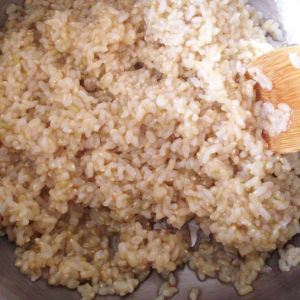
Now, go forth and soak some legumes and grains!
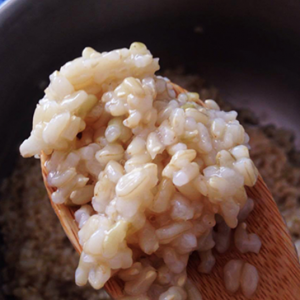
The FACTS: Reasons for choosing brown rice over white rice
- Brown Rice is packed with essential nutrients. The complete milling and polishing that converts brown rice into white rice destroys 67% of its vitamin B3, 80% of vitamin B1, 90% of vitamin B6, half the phosphorus, 60% of the iron and all of the dietary fiber and essential fatty acids. In general, less processing means more essential nutrients.
- Nutritional benefits; Brown Rice is Low GI* – meaning it breaks down slowly in your digestive system and reduces stress on your insulin levels. It also contains loads of GABA*, a natural tranquilizer associated with feeling calm and serene, while at the same time promoting muscle relaxation. Magnesium, which eases muscle cramps, tension, soreness, and fatigue, is also prevalent in brown rice. Last but not least, brown rice contains a variety of antioxidants (anti-aging – say what?) and selenium, which has been shown to help repair DNA in damaged cells, as well as slowing the spread of cancer cells!
- It helps keep you healthy; Not only does brown rice soothe symptoms of asthma, lower high blood pressure, reduce the frequency of migraine headaches and the risk of heart attack and stroke, it also contains fibre, which is essential for digestive health and helps prevent various types of cancer, gallstones and type 2 diabetes.
*The glycaemic index (GI) is a ranking given to food to describe how quickly the carbohydrate in the food is broken down and absorbed into the bloodstream. The GI scale ranges from 0 to 100.
*Gamma-aminobutyric acid, abbreviated as GABA, is an amino acid produced in the brain. It is formed by glutamic acid in the body with the help of vitamin B6 and it prevents nerve cells from firing too often, and, thus, has a calming effect.
Further reading and references:
Antidiabetic Properties of Germinated Brown Rice: A Systematic Review
Chemopreventive Properties of Dietary Rice Bran: Current Status and Future Prospects1,2
Brown Rice-Beyond the Colour Reviving a Lost Health Food – A Review
Replacing white rice with brown rice or other whole grains may reduce diabetes risk
Authored by Yanan Kim,
A Chinese herbalist & acupuncturist;
Stands against health fads &
Advocates life sustaining practices

